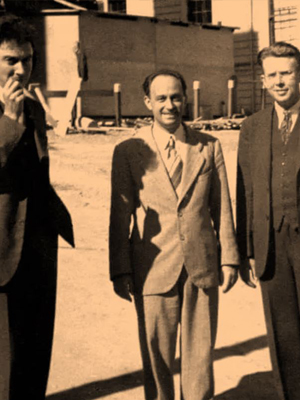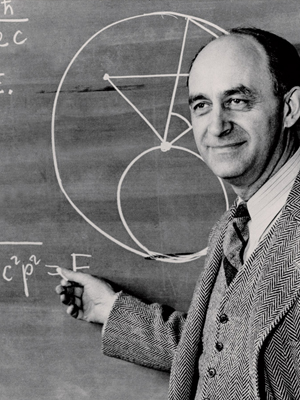Masonic Articles and Essays
Enrico Fermi - Master of the Atom
Very Illus..... Bro... Kristine Wilson-Slack 33°
Date Published:
10/29/2025
Enrico Fermi embodied the union of science and philosophy. A seeker of hidden order, he transformed theory into tangible creation and mystery into method. His calm intellect and devotion to precision reflect the inner discipline of the Mason, who builds not only in stone but in understanding. In his life’s work, the pursuit of light through reason becomes a modern reflection of the ancient quest for the geometry of truth.
 Enrico Fermi, born on September 29, 1901, in Rome, Italy, was a physicist whose work profoundly shaped the 20th century. His early life was marked by a deep passion for physics, leading him to become one of the few scientists adept in both theoretical and experimental physics. His contributions spanned quantum theory, statistical mechanics, and nuclear and particle physics, earning him the moniker "architect of the nuclear age."
Enrico Fermi, born on September 29, 1901, in Rome, Italy, was a physicist whose work profoundly shaped the 20th century. His early life was marked by a deep passion for physics, leading him to become one of the few scientists adept in both theoretical and experimental physics. His contributions spanned quantum theory, statistical mechanics, and nuclear and particle physics, earning him the moniker "architect of the nuclear age."
Fermi’s intellectual curiosity was evident from a young age. After the tragic death of his brother Giulio in 1915, he immersed himself in the study of physics and mathematics. His wife, Laura Fermi, recounted how Enrico would sit on his hands to keep warm while studying and turn the pages of his books with his tongue. This relentless pursuit of knowledge laid the foundation for a lifetime of discovery.
In 1924, Fermi was initiated into the Masonic Lodge "Adriano Lemmi" of the Grand Orient of Italy in Rome. The Adriano Lemmi Lodge, situated in Rome, Italy, holds a significant place in the annals of Italian Freemasonry. Named after Adriano Lemmi, who served as the Grand Master of the Grand Orient of Italy from 1885 to 1896, the lodge reflects the rich history and cultural influence of Italian Masonic traditions.
Adriano Lemmi was a prominent figure in Italian Freemasonry during the late 19th century. His tenure as Grand Master was marked by efforts to enroll representatives of the political and cultural world into the lodges, including notable figures such as Giovanni Bovio, Giosuè Carducci, Agostino Bertani, and Giuseppe Zanardelli.
The lodge named in honor of Lemmi, "Adriano Lemmi," became a center for intellectual and cultural exchange, attracting members deeply committed to the Masonic principles of enlightenment, ethical responsibility, and intellectual growth. It was within this environment that Enrico Fermi was initiated into Freemasonry in the early 1920’s. His association with the Adriano Lemmi Lodge underscores the lodge's reputation as a gathering place for individuals dedicated to pursuing knowledge and improving society.
Fermi's profound intellectual curiosity and commitment to the pursuit of knowledge resonated deeply with the principles of Freemasonry, leading him to attain the degree of Master Mason in 1923. While specific details of his Masonic activities remain scarce, Freemasonry’s emphasis on enlightenment, ethical responsibility, and intellectual growth aligned with his scientific ideals. It provided a philosophical framework that complemented his lifelong dedication to advancing human understanding.
Fermi's scientific journey was marked by groundbreaking discoveries. In 1926, he formulated the statistical laws now known as "Fermi statistics," governing particles that obey the Pauli exclusion principle, later termed "fermions." His work in Rome led to the development of the beta-decay theory in 1934, integrating previous radiation theories with Pauli's neutrino concept. This period also saw his experiments with neutron bombardment, culminating in the discovery of slow neutrons, a pivotal step toward nuclear fission.
 In 1938, Fermi was awarded the Nobel Prize in Physics for his demonstrations of the existence of new radioactive elements produced by neutron irradiation and for his related discovery of nuclear reactions brought about by slow neutrons. Fearing for the safety of his Jewish wife, they began searching for an escape from the impending genocide. Soon after, Enrico and Laura emigrated to the United States, fleeing the Fascist Regime's takeover of Italy.
In 1938, Fermi was awarded the Nobel Prize in Physics for his demonstrations of the existence of new radioactive elements produced by neutron irradiation and for his related discovery of nuclear reactions brought about by slow neutrons. Fearing for the safety of his Jewish wife, they began searching for an escape from the impending genocide. Soon after, Enrico and Laura emigrated to the United States, fleeing the Fascist Regime's takeover of Italy.
Once in the U.S., Fermi joined the Manhattan Project, where he played a crucial role in achieving the first controlled nuclear chain reaction in December 1942 at the University of Chicago. His work laid the foundation for both nuclear energy and nuclear weapons, forever changing the world. Despite his contributions to the development of atomic bombs, Fermi was deeply reflective about the ethical implications of nuclear power.
Upon the discovery of nuclear fission, he went to the University of Chicago, and later to Los Alamos to serve as a general consultant. Brother Fermi contributed significantly to the Manhattan Project, the creation of the first U.S. atomic bomb. As a leading member of the Manhattan Project, Bro. Fermi worked on the development of nuclear energy and the atomic bomb, although he was a vocal critic of the use of the technology as a military weapon.
He labored for the betterment of humanity, yet his research ultimately led to the creation and utilization of the atomic bombs which killed over 200,000 of the citizens of Hiroshima and Nagasaki, Japan. Brother Enrico was adamantly opposed to the utilization of the hydrogen bomb, yet he ultimately argued for the development of knowledge regardless of the consequences of the use of that knowledge.
His wit and humility were as remarkable as his intellect. He once quipped, "If I could remember the names of all these particles, I'd be a botanist," highlighting the complexity of particle physics and his modesty regarding his vast knowledge. He also viewed science through a philosophical lens, once stating, "There are two possible outcomes: if the result confirms the hypothesis, then you've made a measurement. If the result is contrary to the hypothesis, then you've made a discovery." This perspective underscores his belief in the value of unexpected results in advancing scientific understanding.
Fermi’s contributions to education were just as significant as his scientific discoveries. As a professor at the University of Chicago, he mentored and influenced many of the most brilliant physicists of the next generation. His ability to explain complex physical phenomena in simple terms made him a revered teacher, and his insights into quantum mechanics, nuclear reactions, and particle physics paved the way for continued advancements in these fields. His students would go on to shape modern physics, further expanding his influence beyond his own lifetime. Brother Fermi was elected Fellow of the Royal Society on April 27, 1950.
Fermi's legacy is enshrined in numerous honors bearing his name, including the Enrico Fermi Award, the Fermi National Accelerator Laboratory (Fermilab), and the synthetic element fermium. His life and work continue to inspire, reflecting a profound dedication to the advancement of science and humanity. His influence extended beyond the realm of physics into the Masonic traditions he embraced, where the pursuit of knowledge and the enlightenment of mankind remained core to his character.
 Fermi’s later years were marked by continued contributions to physics, particularly in the study of high-energy particles. Even as his health declined, he remained an active mentor and researcher, shaping the next generation of scientists. Unfortunately, in 1954, he was diagnosed with stomach cancer. Despite undergoing surgery and treatment, his condition worsened. On November 28, 1954, at the age of 53, Fermi passed away in Chicago, Illinois. His death marked the loss of one of the greatest scientific minds of the 20th century.
Fermi’s later years were marked by continued contributions to physics, particularly in the study of high-energy particles. Even as his health declined, he remained an active mentor and researcher, shaping the next generation of scientists. Unfortunately, in 1954, he was diagnosed with stomach cancer. Despite undergoing surgery and treatment, his condition worsened. On November 28, 1954, at the age of 53, Fermi passed away in Chicago, Illinois. His death marked the loss of one of the greatest scientific minds of the 20th century.
In his final days, Fermi remained engaged with his work, demonstrating his unwavering commitment to science. He continued to analyze data and propose new theories even as his strength faded. His colleagues and students recalled his stoic determination, his sharp mind never dimmed by his illness. His passing was mourned deeply by the scientific community, but his legacy endures through the knowledge he imparted, the discoveries he made, and the countless individuals he inspired.
His contributions, however, live on through the scientific advancements he pioneered, the institutions named in his honor, and the many physicists he inspired. His legacy is one of brilliance, perseverance, and an enduring impact on both science and humanity.
More Masonic Articles
Explore articles and essays written by Freemasons about Freemasonry.
Read More
Membership
Interested in becoming a member of the worlds oldest Fraternal organization?
Read More